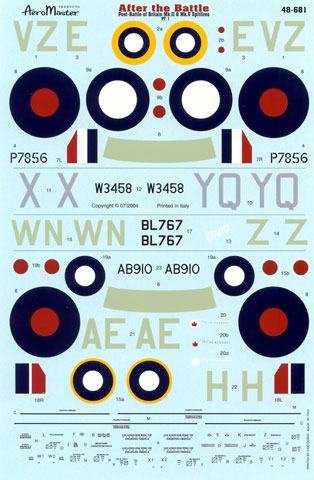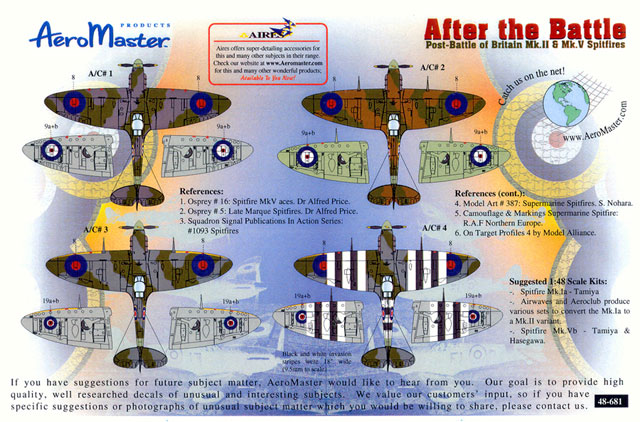As the title suggests, sheet 48-681 from AeroMaster
Products covers Post 1940 Supermarine Spitfires Mk II and Mk Vs.
Markings are provided for four different aircraft in a variety of
camouflage schemes.
 The
individual aircraft and their markings are:
The
individual aircraft and their markings are:
-
Mk II, PZ7856, VZ-E
as flown by Flight Sergeant E.N. McDonnell of 412 (Canadian)
Squadron in October of 1941. The machine is finished in dark green
and mixed grey upper surfaces over light sky blue under surfaces
with a sky spinner and rear fuselage band.
-
Mk Vb W3458, YQ-X
flown by Flight Lieutenant Les 'Buck' Casson of 616 (South
Yorkshire) Squadron in August of 1941. Camouflage is dark earth and
dark green upper surfaces over sky under surfaces with a shy spinner
and rear fuselage band.
-
Mk Vb BL767, WN-Z
"Anna' of 527 (Radar Calibration) Squadron, Digby in early 1945 in
June of 1943. Camouflage is the RAF Temperate Scheme of dark green
and ocean grey upper surfaces over medium sea grey undersides and a
sky rear fuselage band. The spinner is red whilst the backing plate
is white (I'd have a beer on it that it was sky though!).
-
Mk Vb AB910, AE-H
of 402 (Canadian) Squadron, Horne, in June of 1944. The machine is
also in the RAF Temperate scheme with a sky spinner and rear
fuselage band and a full set of D-Day markings. The machine also
sports 'City of Winnipeg' scripts and red maple leaf insignia on a
white circle background. These latter two markings are supplied as
both single and two-part decals to counter any register problems –
none on my sample.
One
set of type A1 fuselage roundels, type B upper wing roundels; type A
under wing roundels and 27" fin flashes will have to be shared between
the first two options whilst each has its own serial number and squadron
codes provided. The red centres of the roundels (with the exception of
the type Bs) are supplied separately in case of register problems.
The
two Temperate Scheme machines also share a single set of type C1
fuselage roundels, type C under wing roundels and type B upper wing
roundels and a pair of 24" fin flashes. A single complete set of
stencil data completes the provided markings.
The
placement guide is A-4 in size. It shows left hand side colour profiles
of, as well as plan views of the topsides and scrap views of the wing
under surfaces for each option. There is a further three-view drawing
that shows the stencil data placement albeit for a Mk IX.

The
decals have been printed by Cartograf.
Recommended.
Home | What's
New | Features
| Gallery |
Reviews | Reference
| Forum
| Search